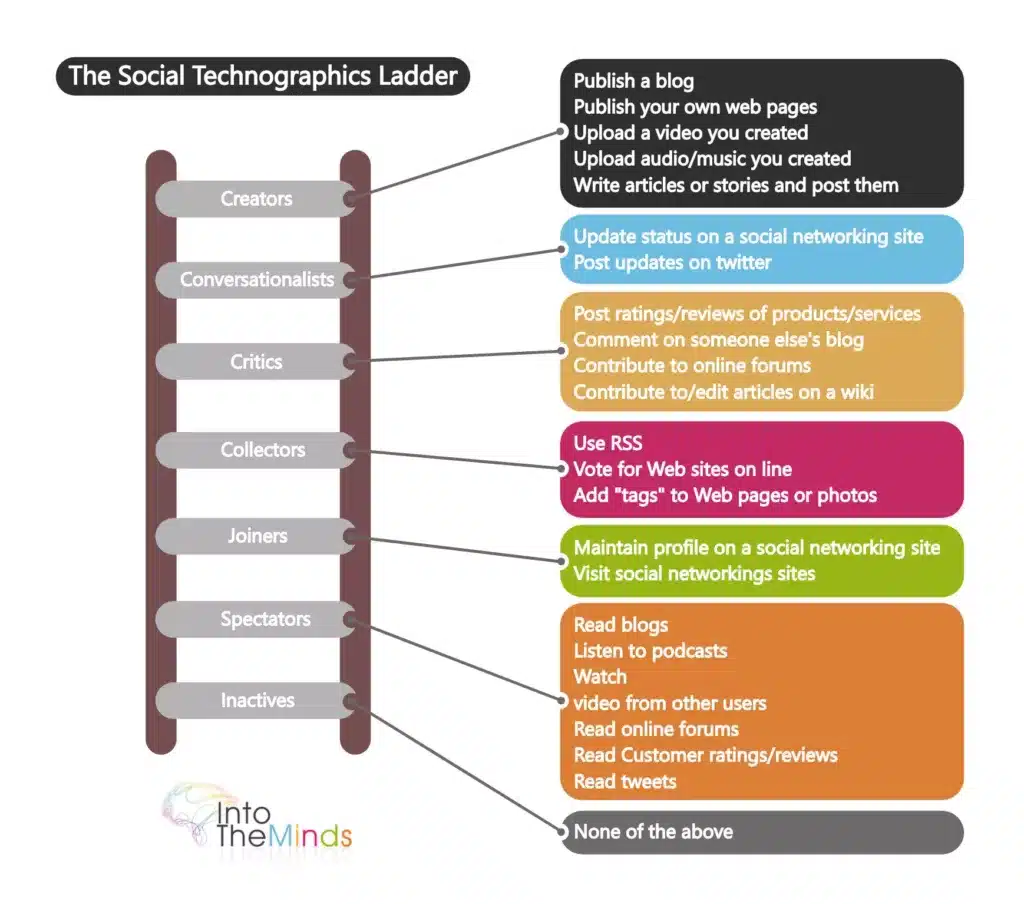The dynamics of social networks depend on their users. They can be analyzed according to their content creation/consumption profile. There are 7 profiles, which we analyze here.
Contact IntoTheMinds research agency
The 7 types of social network user
Research into the use of social networks generally uses a segmentation such as that proposed by Forrester (see above). This is a practical model for an initial understanding of online behavior.
| User profile | Description | Insights |
| Creators | Publish blog articles and web pages, create podcasts or videos, and post content on social networks. | These users are the most active and influential on social media, often the originators of trends and new topics. They are the main drivers of content creation and opinion-forming. The fruits of their creation can significantly impact brand perception and consumer behavior. |
| Conversationalists | Update their status on social networks, post updates on Twitter. | This group actively participates in dialogues and discussions, often shaping the narrative around topics. They are crucial in disseminating information and can influence their network through regular interactions and subjective opinions. |
| Critics | Publish product reviews, comment on blogs, contribute to forums, and edit wikis. | Critics play a vital role in shaping public perceptions of products and services. Their opinions and comments can influence consumer decisions and are often sought after for their expertise or experienced point of view. |
| Collectors | Use multiple social networks, adding tags to web pages/photos. | Collectors help organize and arrange content, making it more accessible and understandable to others. Their activities support the structure and navigation of online content, helping to make it discoverable and relevant. |
| Spectators | Maintiennent des profils sur les réseaux sociaux, visitent ces sites. | Les adhérents représentent la base plus large des utilisateurs de médias sociaux. Bien qu’ils soient moins actifs dans la création de contenu, leur participation par le biais de la maintenance de profil et des visites de sites contribue à l’écosystème global, fournissant un public et un potentiel d’engagement. |
| Spectateurs | Read blogs, listen to podcasts, watch videos, read forums and customer reviews. | While not actively contributing, Spectators form the largest social media segment. They are the first to be impacted by published content and are essential to virality. |
| Inactive | Don’t engage in any of the above activities. | Inactives don’t participate directly in social media dynamics. Nevertheless, they represent a potential audience. By understanding why, they are inactive, we can extend the reach of social media. |
What motivates people to use social media?
What are the reasons that drive people from one level to the next? You’ll agree that the higher up the ladder you go, the fewer people you’ll find in each category. Logically, the “creator” level has fewer members than the “spectator” level. Yet, it takes work to pinpoint what motivates people to go higher.
Research has been conducted to understand better the motivations of the 7 distinct types of social network users. This research is based on diaries, an interesting qualitative research method. This research shows that users are not “stuck” at one level. They can move from one state to another, depending on their goals and the information they consume. But in any case, they must have goals and be rewarded.
This reward, which can be at the root of social networking addictions, can take different forms:
- For a collector, the number of fans is a good indicator of your popularity and the impact you can have. It’s their reward.
- For Conversationalists (those who like to chat online), the number of comments they generate or the conversation density they help fuel is also a reward.
- For creators (bloggers, for example), traffic statistics (number of visitors) are their drug.
Conducting a user from one segment to another, therefore, requires providing an incentive.
Why are there fewer creators than collectors?
Users’ propensity to move up the ladder is determined by their own will, incentives, and a more subtle stimulus: effort. This is the effort they must deploy in relation to the reward they can expect.
This ratio explains the scarcity of users in the upper segments of the market. For collectors (increasingly referred to as “curators”), the “effort/followers” ratio is low, while for bloggers, the same ratio is much higher. In the first case, you need a limited amount of effort to obtain a large number of fans quickly. In the second case, making a blog popular takes a lot of effort, time, and discipline. The higher the ratio (high effort for low fan numbers), the lower the motivation.
Posted in Research.
